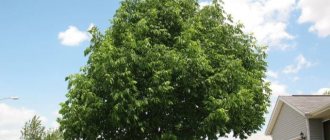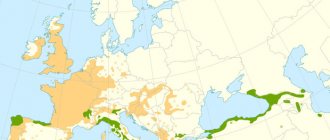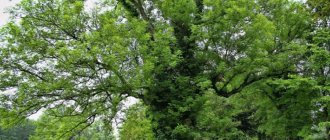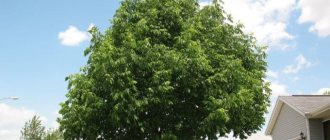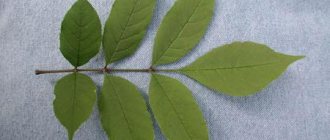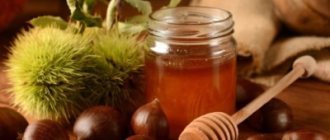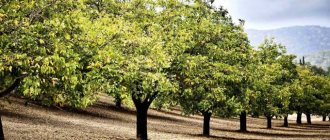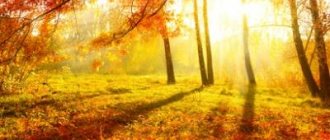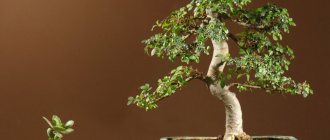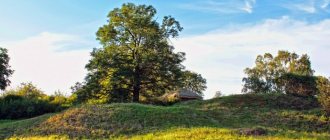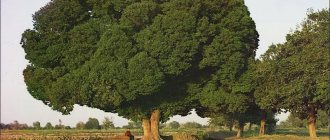Description of the genus
Elm (from Latin ulmus laevis) is compared to oak in its majesty and power. This is a relict species, the lifespan of which trees goes back several centuries. The growing area of elm species is extensive; in Russia they are found in several subspecies; in addition, they can be seen in North America and Europe.
This genus of trees is found both as single representatives and in mixed plantings. They also feel quite good in poor soils, but mostly grow on fertile lands. This type of tree grows upward even when there is not enough sun. At the same time, the growth rate of elm is very high. The growth per year is about 50 cm in height, and in trunk girth up to 0.3 meters.
A mature elm can reach 40 meters, but there are also species that resemble shrubs. The surface of the bark of a young elm is without roughness, light brown in color, and over time it becomes covered with vertical grooves. The root system of the tree is powerful, the roots penetrate to a depth of 30 meters with a trunk with a girth of 1.5 meters. But some species have their roots spread out rather than deep, covering vast areas.
Elm leaves differ significantly from other species in their elongated oval shape and jagged edges. Leaf size is from 4 to 20 centimeters. They are located alternately on the branches and are attached to them with short cuttings. In autumn they change color from green to red-brown and the crown quickly thins out.
The tree blooms in the spring, before it becomes overgrown with leaves. The inflorescences are small, yellow in color. Elm seeds are small winged nuts. They ripen in the last days of May, and the wind scatters them throughout the surrounding area. If the conditions are right, they can germinate within a few days.
How to plant elm?
The procedure is no different from ornamental or fruit trees. The description of the elm tree includes the following manipulations during planting:
- dig a hole larger than the root system;
- apply fertilizer and transfer the seedling with the root ball;
- fill the remaining voids;
- compacted and watered.
At first, the seedling needs shelter from direct sunlight, while in the shade the plant will not fully develop. Before full rooting, it is important that the soil is constantly moist. An important point in planting is choosing the right place; an extensive root system can harm neighboring trees and other plantings.
Types of elms
Elm is the most common species of elm. It easily adapts to negative weather conditions and tolerates temperatures down to -28 °C. Popular tree subspecies include:
- The elm is smooth, stretches up to a height of 25 meters, the table is covered with bark with a pronounced relief, of a dark brown hue. The leaves are large. Elm differs from other varieties in the shade of its foliage; it is dark green on one side and light on the other, covered with a light fluff. The flowers of this tree are purple with a hint of burgundy.
- The squat elm, living up to its name, is small in size. It reaches a height of up to 15 meters and often looks like a bush. Most often found in the Far Eastern region. The leaves are small, soft green in color. Inflorescences are yellow-brown, small.
- Rough elm. Grows in rich soils. Most often found in mixed forests. The trunk is covered with smoother bark than other species. Reaches 40 meters. The foliage is large, green, with an uneven surface.
Elm - what kind of tree is this?
The name comes from the word "elm". The elm tree belongs to the deciduous genus and is a close relative of the elm. There are many legends about this plant. One of them says that evil spirits seek shelter in its branches and those who carry a piece of bark with them are protected. There are people who are sure that a piece of a branch will return lost strength, help them find the meaning of life and solve problems.
Many people are interested in where the elm tree grows. The greatest distribution is observed in Asia and the Southern Urals. In this area, trees create entire deciduous forests. The wood obtained from this species is a semi-precious species and is used to make various products, from spoons to a variety of furniture. The lifespan of a tree reaches 300 years.
What does an elm tree look like?
In order to understand what an elm tree looks like, you need to know its main characteristics:
- height about 30 m;
- crown diameter up to 1.3 m;
- large foliage with carved edges;
- color from light green to rich;
- flowers are small, greenish in color;
- bloom in April-May;
- the fruits resemble plates with seeds inside;
- the bark is rough with a rough surface;
- elm wood of a dark red or brown hue;
- The root system has both superficial and deep processes.
Planting and care
Planting elm in the local area is not difficult. You will need ripe, dried seeds. Shoots appear a few days after immersion in the ground. It is important to remember that germination quickly disappears, so it is important not to waste time. Elm fruits should be planted according to the following algorithm:
- It is necessary to collect the seeds after flowering has completed. After this, they are placed in nutrient soil or wet cotton wool. It is advisable to pre-treat the fruits with anti-fungal agents.
- After a few days, the seeds are planted in a container with soil. The best choice in this situation would be black soil, as this will increase the growth rate. But humus with leaves will also work. Be sure to choose a soil that is soft and sufficiently moist.
- The seeds are immersed to a depth of 1-2 cm, the distance between the holes should be approximately 25 cm. The ground is covered with moss, dry grass or cotton wool. The soil is moistened every day. After 10 days, you can see the young elm and remove the covering material.
It is advisable to frequently place the sprouts in the sun. In the absence of precipitation and wind, it is good to leave the container with young sprouts on the balcony or in the garden in the air. During the first year, the plant reaches 20 cm. The seedling can be planted in the ground in the second year.
In the first years, elm must be protected from excessive wind and low temperatures. For the winter, the tree must be covered with special material. It is important to remember that soil saturation affects how roots form, so poor soil needs to be fertilized. It is also important to regularly loosen the soil around the shoot.
Over the course of a year, the elm grows 40-50 cm in height. The branches are not pruned for 1-2 years; the crown is required to form. Only diseased or dry branches should be removed. It is permissible to trim the crown while the seedling is growing.
How to get rid of an elm tree?
With its beauty and benefits, sometimes situations arise when you need to get rid of a plant. An easy way is to cut or dig, but in some situations this is not possible. In this case, the elm elm is removed using a chemical method. To do this, you can use watering, spraying, grafting, introducing the drug into the soil, or applying it to the bark. Among the well-known ones are the following: “Sodium nitrate”, “Ammonia nitrate” or “Arsenal”. Alternative methods include:
- Use of salt. Watering is carried out with a concentrated salt solution. The larger the tree, the greater the quantity required.
- Root tiling. They are filled with concrete to the very foundation. This leads to a blockage of oxygen and moisture. On average, the roots die after a month.
- Shutting off the air supply with mulch. A layer of mulch 15 cm high is laid over the roots. The same is done with the trunk. This partially blocks the supply of nutrients, which leads to death.
Diseases and pests
Typically, elm is affected by elm springtail, scale insects, and leaf beetles. It is easy to identify a disease in a tree; its crown dries out and growths appear on the bark. To combat parasites, treatment with liquid copper sulfate, insecticides and fungicides is used.
Young trees are easier to get rid of diseases. Old elms are difficult to get rid of parasites, especially fungi. That is why the use of antifungal agents is recommended at the planting stage.
Bloom
Black poplar is a dioecious plant, that is, it has female and male specimens. The flowers are long thin earrings hanging on the shoots. They form in early May, almost simultaneously with the opening of leaf buds. The male ones are very beautiful: fringed, purple-burgundy, up to 11 cm long. The female ones are about 5–6 cm, yellowish, and after fertilization they increase 1.5 times. Sedge is pollinated by the wind . After 1–1.5 months, the seeds ripen. They are enclosed in small dry bivalve boxes, covered with white hairs. Dispersed by the wind. Down facilitates transport over distances of up to several kilometers.
Sedge begins to bloom and bear fruit at the age of 10–20 years . One individual produces several million seeds, most of them germinate. At the beginning of June, poplar “snowfall” usually occurs in the middle zone. Down covers the streets and courtyards, flies into rooms, causing allergy attacks. In dry, warm, windy weather, fruit boxes begin to spread especially actively. To prevent this situation, only specimens of one sex can be planted.
Black poplar lives 300–350 years and is the most durable among other related species. Old trees become thick, stumpy, and expand in width.
Meaning and Application
It is difficult to overestimate the importance of elm. Its bark, fruits and leaves are successfully used in folk medicinal recipes. It is important to talk to your healthcare professional before using elm in the treatment of various diseases. Therapy has side effects and contraindications.
Decoctions based on bark and leaves help reduce inflammation, have antibacterial properties, and help heal damage. The extract is used for the treatment of kidney, heart, blood vessels, thyroid gland, etc.
A decoction is useful for throat diseases. So, if you have a sore throat, it is recommended to gargle with it. Tea from the leaves is used for constipation. In case of hemorrhoids and kidney diseases, baths with elm bark are recommended. The tincture is used to get rid of skin rashes.
Elm wood is often used in industrial production due to its excellent properties. Elm wood is often used as an alternative to expensive wood species. Its texture allows you to imitate valuable varieties, with a fairly light color. Mahogany connoisseurs love elm. Elm is used to make furniture for the home and is also used to make paintings.
The density of elm wood is very high, approximately 600 kg/m3. The cut of wood has a beautiful texture, which makes it suitable for use in carpentry. It is resistant to rotting processes and is difficult to split and saw. However, it behaves very well when polished.
In the old days, elm was also used in carpentry workshops, and paint was made from its bark. Without taking into account the pests that attack the tree, it is often planted in parks, around the city, and in social institutions.
Elm tree - properties
In addition to high-quality wood, elm has various positive qualities used in folk medicine.
- A decoction of the bark is used for diarrhea, it helps with gastritis and ulcers.
- An infusion of the leaves helps with colic.
- The gruel promotes wound healing.
- Compresses help with scabies and eczema.
- Preparations based on this tree restore the functioning of the heart muscle and normalize metabolic processes in the body.
- An infusion of the bark is effective for cystitis.
- The fruit-based drug is used to relieve inflammation and restore the epithelium.
Use in landscape design
The elm looks like a mighty, strong tree with a dome-shaped crown. It is the dense foliage that allows it to be used as a barrier against dust, gases, and dirty air for residential areas. Moreover, in addition to such an important practical function, elm forms a beautiful, green landscape.
The crown of elms is often used to create shapes in landscape designs. The density of the branches allows you to cut a wide variety of shapes. Powerful, strong roots of the tree can strengthen the banks of lakes, rivers, and the slopes of ravines. Thus, planting elm, in addition to its decorative function, will fulfill an important, practical role.
Elm is an excellent solution for a personal garden. In addition to the obvious landscaping, it will strengthen the soil. Thanks to this, fertile soils will not slide and will be preserved from weathering and erosion.
When deciding to plant elms, it is important to take into account their subspecies and dimensions. Since the diversity of elm is great, there are both miniature and huge specimens.
So, a tall, spreading tree is not suitable for a small area. And over a large area there will not be enough bushes.
